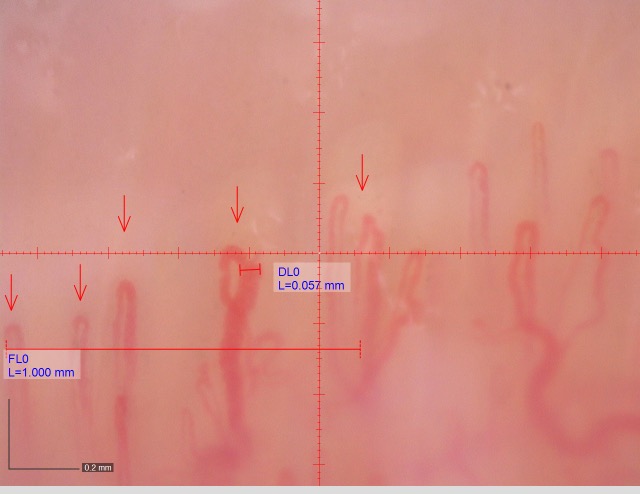Session Information
Date: Monday, November 13, 2023
Title: (1221–1255) Pediatric Rheumatology – Clinical Poster II: Connective Tissue Disease
Session Type: Poster Session B
Session Time: 9:00AM-11:00AM
Background/Purpose: Nailfold video capillaroscopy (NVC) is useful in diagnosing secondary Raynaud’s phenomenon (RP) and predicting systemic sclerosis (SSc) and other CTD in adults. Recent studies indicate its potential application in children with positive antinuclear autoantibodies (ANA), irrespective of the presence of RP. We aimed to evaluate microvascular abnormalities in children using NVC in a cohort of pediatric Chilean patients.
Methods: This cross-sectional study included children between 5 to 18 years with diagnosis of CTD, RP and/or positive ANA. Using a 200 magnification DinoLite microscope, NVC findings were according to the standardized international consensus definitions from the EULAR Study Group on Microcirculation in Rheumatic Diseases into normal, non-specific and SSc patterns. ANA were detected through routine clinical care by indirect immunofluorescence techniques on HEp-2 substrate and/or immunoblotting ANA Profile 23 Ag. Extractable nuclear antibodies (ENA) were detected by Enzyme-Linked Immunosorbent Assay.
Results: 28 children were consecutively included. Median age was 12 years (interquartile range (ICR) 8-14), and 79% were female (n=22). 57% of the patients had CTD/RP (n=16) and 43% (n=12) had a positive ANA without features of CTD/RP. Non-specific abnormalities were the most frequent pattern (n=25, 89%). The SSc pattern was found in 2 patients, and 1 patient had a normal NVC pattern. The patient with normal pattern was a healthy child without CTD and with high titers of DFS70 antibody on ANA immunoblotting. The 2 patients with SScPattern had a clinical diagnosis of MCTD with RP and high titers of RNP/Sm antibody, and exhibit an active SSc pattern on NVC. Patients with positive ANA without CTD/RP had a median of 6.5 capillaries/mm (ICR 6-7) and a median apical diameter of 21,5 μm (ICR 17-24) . Most of them had a non-specific NVC pattern (n=11, 92%), and dilated capillaries were present in 50% (n=6), without microhemorrhages or giant capillaries. Patients with CTD/RP had a median apical diameter of 22.5 μm (ICR 17.5-24). Most of them had dilated capillaries (75%, n=12), and 88% (n=14) had a non-specific pattern. Patients with a positive ANA without CTD/RP had significantly lower median apical diameters than those with CTD/RP (p=0.0091). In univariate analysis, CTD/RP (p=0.0091), and the presence of RP (p=0.0048) were associated with higher median apical diameters. High titers of RNP/Sm antibodies on ENA panel (p=0.0376), positive Sm (p=0.0376), and positive La autoantibodies (p=0.0376) were associated with higher apical diameters. In the ENA panel, high titles of RNP/Sm (p=0.0211), positive Sm (p=0.0211) and positive La (p=0.0211) were associated with fewer capillaries.
Conclusion: This study adds further knowledge of NVC technique and methodology in children and adolescents. Our results highlight the potential utility of regular use of NVC in pediatric patients with positive ANA, RP and CTD.
To cite this abstract in AMA style:
Espinosa Y, Concha S, Schulze C, Valenzuela A. Nailfold Video Capillaroscopy and Its Association with Autoantibodies and Rheumatic Diseases in Pediatric Patients [abstract]. Arthritis Rheumatol. 2023; 75 (suppl 9). https://acrabstracts.org/abstract/nailfold-video-capillaroscopy-and-its-association-with-autoantibodies-and-rheumatic-diseases-in-pediatric-patients/. Accessed .« Back to ACR Convergence 2023
ACR Meeting Abstracts - https://acrabstracts.org/abstract/nailfold-video-capillaroscopy-and-its-association-with-autoantibodies-and-rheumatic-diseases-in-pediatric-patients/

